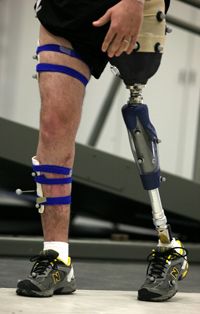Making Prosthetic Limbs
Because each patient and his or her amputation are unique, each prosthetic limb must be custom fitted and then built. This is the task of a prosthetist, who specializes in the fabrication and fitting of prosthetic limbs. Because prosthetists work to interface artificial devices with the human body, they need a wide range of skills in areas such as engineering, anatomy and physiology.
The design and fabrication process consists of several different steps and begins with a precise measurement process later used to design the prosthetic limb. If possible, a prosthetist begins taking measurements before the patient's limb is even amputated, so that the fabrication process can get started. For example, detailed measurements of the patient's body are taken to help correctly size the prosthetic limb. The prosthetist and doctor also meet before the surgery to discuss details of the operation.
Advertisement
Several weeks after the amputation surgery, once the wound has had a chance to heal and the swelling has gone down, a plaster mold is taken of the residual limb. This mold then serves as a template for making a duplicate of the residual limb. The duplicate of the residual limb is then used to test the fit of the prosthetic limb as it's being built. Newer technologies allow computerized digital measurements to be taken as well. Careful attention is also paid to the structure of the patient's residual limb, including the location of any muscles, tendons and bones. The health of the patient and condition of the skin are other factors taken into account when designing the prosthesis.
Physical therapy after an amputation and prosthetic device fitting is extremely important. Learning to walk with a prosthesis can be an especially difficult undertaking, requiring several months of rehabilitation and training. Therapy might also focus on using the prosthetic device to perform important everyday activities. For a leg prostheses, the prosthetist carefully monitors the walking gait of the patient and makes adjustments as necessary.
The prosthetist pays especially close attention to the interface between the patient's residual limb and the prosthetic socket. After an amputation, a patient's residual limb will typically shrink over the course of several months as swelling diminishes and muscles begin to atrophy, or shrink from lack of use. It's possible that new sockets may need to be fitted to accommodate the reduction in size. Layers of sock-like dressings can also be varied to accommodate for the changing size of the residual limb. A prosthetist must work especially closely with children, to make sure that their prosthetic limbs are resized or replaced as necessary to keep up with their natural growth.
A patient will continue to visit the prosthetist throughout his or her life, since residual limbs can always change shape and prosthetic devices eventually break down. In fact, according to the National Limb Loss Information Center, an average prosthetic device has a lifespan of only three years.
Read on to find out how a patient is able to control a prosthetic limb.
